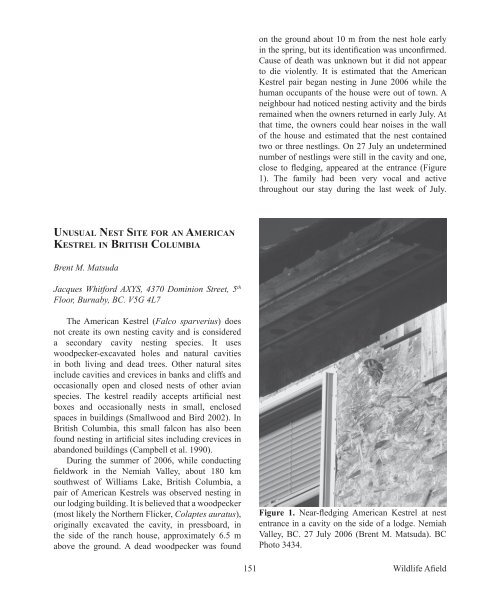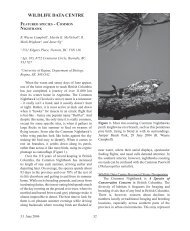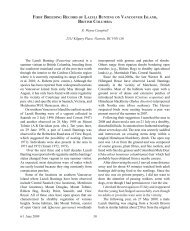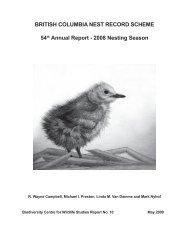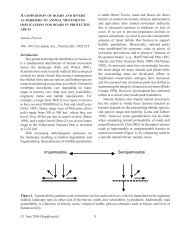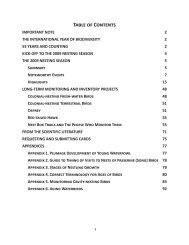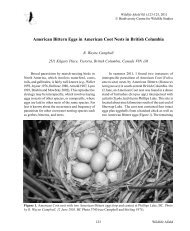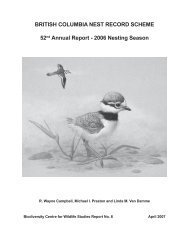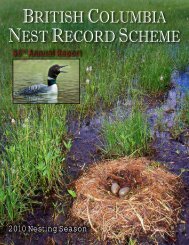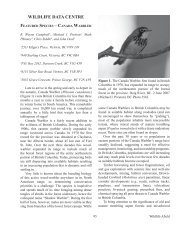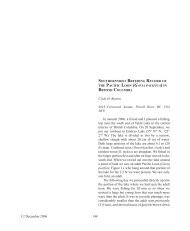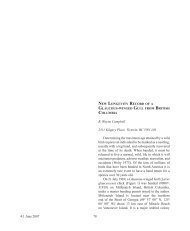American Kestrel - Biodiversity Centre for Wildlife Studies
American Kestrel - Biodiversity Centre for Wildlife Studies
American Kestrel - Biodiversity Centre for Wildlife Studies
You also want an ePaper? Increase the reach of your titles
YUMPU automatically turns print PDFs into web optimized ePapers that Google loves.
Kootenay National Park, Radium Hot Springs, BC.<br />
153 pp.<br />
About the Authors<br />
Dean is a naturalist living in Cranbrook. He<br />
regularly takes part in Christmas Bird Counts and<br />
other bird-watching events in the East Kootenay. In<br />
addition to birds, Dean studies butterflies, moths, and<br />
dragonflies in the East Kootenay.<br />
Valerie is a naturalist living in Cranbrook. In<br />
addition to having an interest in local birds, she has<br />
a keen interest in local vascular plants and has been<br />
participating in a three-year survey project in Mount<br />
Assiniboine Provincial Park.<br />
UNUSUAL NEST SITE FOR AN AMERICAN<br />
KESTREL IN BRITISH COLUMBIA<br />
Brent M. Matsuda<br />
Jacques Whit<strong>for</strong>d AXYS, 4370 Dominion Street, 5 th<br />
Floor, Burnaby, BC. V5G 4L7<br />
The <strong>American</strong> <strong>Kestrel</strong> (Falco sparverius) does<br />
not create its own nesting cavity and is considered<br />
a secondary cavity nesting species. It uses<br />
woodpecker-excavated holes and natural cavities<br />
in both living and dead trees. Other natural sites<br />
include cavities and crevices in banks and cliffs and<br />
occasionally open and closed nests of other avian<br />
species. The kestrel readily accepts artificial nest<br />
boxes and occasionally nests in small, enclosed<br />
spaces in buildings (Smallwood and Bird 2002). In<br />
British Columbia, this small falcon has also been<br />
found nesting in artificial sites including crevices in<br />
abandoned buildings (Campbell et al. 1990).<br />
During the summer of 2006, while conducting<br />
fieldwork in the Nemiah Valley, about 180 km<br />
southwest of Williams Lake, British Columbia, a<br />
pair of <strong>American</strong> <strong>Kestrel</strong>s was observed nesting in<br />
our lodging building. It is believed that a woodpecker<br />
(most likely the Northern Flicker, Colaptes auratus),<br />
originally excavated the cavity, in pressboard, in<br />
the side of the ranch house, approximately 6.5 m<br />
above the ground. A dead woodpecker was found<br />
151<br />
on the ground about 10 m from the nest hole early<br />
in the spring, but its identification was unconfirmed.<br />
Cause of death was unknown but it did not appear<br />
to die violently. It is estimated that the <strong>American</strong><br />
<strong>Kestrel</strong> pair began nesting in June 2006 while the<br />
human occupants of the house were out of town. A<br />
neighbour had noticed nesting activity and the birds<br />
remained when the owners returned in early July. At<br />
that time, the owners could hear noises in the wall<br />
of the house and estimated that the nest contained<br />
two or three nestlings. On 27 July an undetermined<br />
number of nestlings were still in the cavity and one,<br />
close to fledging, appeared at the entrance (Figure<br />
1). The family had been very vocal and active<br />
throughout our stay during the last week of July.<br />
Figure 1. Near-fledging <strong>American</strong> <strong>Kestrel</strong> at nest<br />
entrance in a cavity on the side of a lodge. Nemiah<br />
Valley, BC. 27 July 2006 (Brent M. Matsuda). BC<br />
Photo 3434.<br />
<strong>Wildlife</strong> Afield
Young would call from inside the nest hole while an<br />
adult was vocalizing from trees 50 m away. By the<br />
end of the month an unknown number of young had<br />
fledged and shortly thereafter all the kestrels left the<br />
nest <strong>for</strong> good.<br />
Other nest sites in buildings in British Columbia<br />
have all been in small openings or crevices in walls<br />
and roofs (R. W. Campbell, pers. comm.). The Nemiah<br />
Valley nest appears to be the first documented use<br />
of a woodpecker hole in a building, which in itself<br />
seems unusual.<br />
The nesting chronology falls within the<br />
period listed by Campbell et al. (1990) <strong>for</strong> British<br />
Columbia.<br />
Acknowledgements<br />
Thanks are extended to John and Tracy Tanis<br />
<strong>for</strong> their hospitality and providing early season<br />
in<strong>for</strong>mation on the chronology of the nesting kestrels.<br />
Jacques Whit<strong>for</strong>d Environmental Ltd. supported the<br />
fieldwork being conducted in the area at the time of<br />
this observation.<br />
Literature Cited<br />
Campbell, R.W., N.K. Dawe, I. McTaggart-<br />
Cowan, J.M. Cooper, G.W. Kaiser, and M.C.E.<br />
McNall. 1990b. The birds of British Columbia:<br />
Volume 2 – nonpasserines (diurnal birds of prey<br />
through woodpeckers). Royal British Columbia<br />
Museum, Victoria, BC. 636 pp.<br />
Smallwood, J.A., and D.M. Bird. 2002.<br />
<strong>American</strong> <strong>Kestrel</strong> (Falco sparverius). In The Birds of<br />
North America, No. 602. (A. Poole and F. Gill, eds.).<br />
The Birds of North America, Inc., Philadelphia, PA.<br />
32 pp.<br />
About the Author<br />
Brent is a wildlife biologist/naturalist and<br />
consultant who recently returned to Vancouver after<br />
working in Cali<strong>for</strong>nia <strong>for</strong> the past five years. While<br />
typecast as a herpetologist, most of his professional<br />
work has been with birds. However, he prefers to<br />
work on a variety of taxa, whether in Canada or<br />
abroad.<br />
3:2 December 2006 152<br />
WILDLIFE DATA CENTRE<br />
FEATURED SPECIES - HEERMANN’S GULL<br />
R. Wayne Campbell l , Michael I. Preston 2 , Spencer G.<br />
Sealy 3 , Bob Hansen 4 , and Michael G. Shepard 5<br />
1 2511 Kilgary Place, Victoria, BC. V8N 1J6<br />
2 940 Starling Court, Victoria, BC. V9C 0B4<br />
3 Department of Zoology, University of Manitoba,<br />
Winnipeg, MB. R3T 2N2<br />
4 Pacific Rim National Park Reserve, PO Box 280,<br />
Ucluelet, BC. V0R 3A0<br />
5 533 Foul Bay Road, Victoria, BC. V8S 4G9<br />
Of the 23 kinds of gulls in British Columbia<br />
there is one species that has been coined “antigull”<br />
because its appearance is unlike any other gull on the<br />
Pacific coast. Also, instead of migrating south after<br />
the breeding season it flies north. Heermann’s Gull<br />
(Larus heermanni) is the only species that does not<br />
show the typical gray back and white belly. Adults<br />
are unmistakable with their pure white heads and<br />
necks, dusky bodies, and black tails. Immatures and<br />
juveniles have sooty brown bodies. In all age groups,<br />
the Heermann’s Gull is the only gull with a twotoned<br />
bill at all ages (Figure 1).<br />
The entire world’s population of Heermann’s<br />
Gull nests on a handful of islands in the Gulf of<br />
Cali<strong>for</strong>nia, Mexico. After the breeding season,<br />
in late May, adults and immatures start to migrate<br />
north instead of south along the west coast of North<br />
America. This “reverse” migration is rare in birds,<br />
and unique in Pacific coast gulls. By late June and<br />
early July, migrants have reached coastal areas of<br />
southern British Columbia, which is the northern<br />
limit of their summer exodus.<br />
Heermann’s Gull spends about four months<br />
loafing, preening, moulting, and feeding in the<br />
province and by the end of October only stragglers<br />
remain. Most of the population spends the winter<br />
along the coast of western North <strong>American</strong> in<br />
Cali<strong>for</strong>nia and Mexico.<br />
This little-studied Pacific gull feeds mainly on


